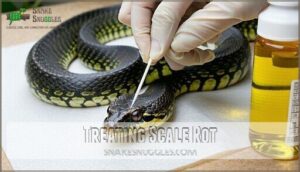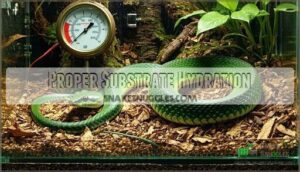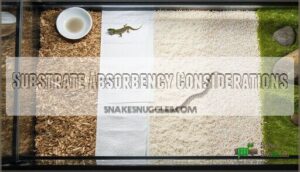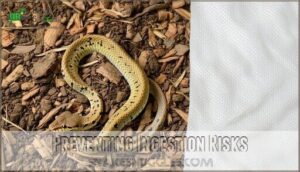This site is supported by our readers. We may earn a commission, at no cost to you, if you purchase through links.
 Scale rot in pet snakes, everything you need to know starts with recognizing the red flags. You’ll spot discolored, soft, or peeling scales on your snake’s belly first.
Scale rot in pet snakes, everything you need to know starts with recognizing the red flags. You’ll spot discolored, soft, or peeling scales on your snake’s belly first.
This bacterial infection thrives in damp, dirty conditions. Poor husbandry is usually the culprit—think soggy substrate, high humidity, or infrequent cleaning.
Early cases respond well to betadine baths and improved habitat conditions. Severe infections need antibiotics from an exotic vet.
Prevention beats treatment every time. Keep substrate dry, maintain proper humidity levels, and clean regularly. Your snake’s belly scales are like canaries in a coal mine for habitat health. Smart substrate choices make all the difference.
Table Of Contents
- Key Takeaways
- What is Scale Rot?
- Getting a Proper Diagnosis
- Treating Scale Rot
- Preventing Future Outbreaks
- TimmyG’s Snake Battles Recurrent Scale Rot
- How to Choose The Right Substrate
- Frequently Asked Questions (FAQs)
- What to do if my snake has scale rot?
- Is scale rot an emergency?
- What is the progression of scale rot?
- What does the start of scale rot look like?
- How long does it take for scale rot to heal?
- Can scale rot spread to other reptiles in the same enclosure?
- Is scale rot contagious to humans?
- Is scale rot contagious to other reptiles?
- How long does scale rot take to heal?
- Can scale rot cause permanent scarring or damage?
- Conclusion
Key Takeaways
- You’ll spot scale rot early by checking your snake’s belly scales for discolored patches, blisters, or crusty edges – catching it fast prevents serious complications and speeds recovery.
- Poor husbandry causes scale rot, so you must keep substrate dry, maintain proper humidity levels (50-60%), and clean your snake’s enclosure regularly to prevent bacterial infections.
- You can treat mild cases at home with daily betadine baths and antibiotic ointment, but severe infections need prescription medications from an exotic vet to avoid permanent scarring.
- Prevention beats treatment every time – choose absorbent substrates like paper towels or aspen shavings, monitor moisture levels with a hygrometer, and quarantine new snakes to protect your pet’s health.
What is Scale Rot?
Scale rot is a bacterial infection that affects your snake’s skin and scales when you don’t maintain proper habitat conditions like cleanliness, temperature, and humidity.
When your snake’s home isn’t clean, their skin pays the price with painful bacterial infections.
You’ll typically see this condition develop on your pet’s belly scales where they contact dirty substrate, causing discolored patches, blisters, and raised scales that can spread if left untreated, which is a result of poor maintenance of the snake’s environment, particularly the lack of cleanliness.
Warning Signs
Spotting snake scale rot early can save your pet from serious complications.
You’ll notice infected snake scales showing telltale signs that demand immediate attention.
Watch for these key snake disease symptoms:
- Early Discoloration – Brown, red, or black patches on belly scales
- Blister Formation – Clear or yellow fluid-filled bumps on skin
- Scale Appearance – Crusty, raised, or curled edges indicating infection
- Appetite Loss – Refusing food signals underlying snake skin problems
- Behavioral Changes – Increased aggression, lethargy, or excessive rubbing
These snake scale discoloration patterns typically appear on ventral scales first, where moisture accumulates most.
Causes
Understanding what triggers snake scale rot causes helps you protect your pet.
Unsanitary habitats top the list—dirty substrates harbor bacteria that attack your snake’s skin.
Poor humidity control creates the perfect storm for snake bacterial infection and snake fungal infection.
Temperature issues weaken immunity while damaged scales provide entry points.
Poor nutrition leaves your snake defenseless against these habitat conditions, and unsanitary habitats can lead to a combination of issues, including bacterial infection.
Getting a Proper Diagnosis
The right diagnosis sets the foundation for effective scale rot treatment in your snake.
When you suspect snake scale rot, a vet consultation becomes your first line of defense against this common reptile condition.
Your reptile veterinarian will conduct a thorough evaluation to confirm snake diseases diagnosis and rule out other conditions through differential diagnosis.
Early detection substantially improves treatment outcomes and prevents complications.
Here’s what your vet will examine during the diagnostic process:
- Physical Examination – Your vet will inspect snake scale rot symptoms like discolored scales, blisters, and swollen areas on your snake’s belly and body.
- Diagnostic Testing – Microscopic analysis of skin samples helps identify specific bacteria or fungi causing the infection.
- Environmental Assessment – Your vet will review your snake’s habitat conditions, humidity levels, and substrate to pinpoint underlying causes.
This thorough approach guarantees accurate diagnosis and targeted treatment for your snake’s recovery.
Treating Scale Rot
Once you’ve confirmed your snake has scale rot, you’ll need to act quickly to prevent the infection from spreading.
Treatment options range from simple at-home care using betadine baths and antibiotic ointments to prescription medications from an exotic veterinarian for severe cases.
At-Home Treatment Options
Once you’ve identified scale rot, you can start treatment at home for mild cases. Your first line of defense involves several proven methods that many snake owners find effective.
Betadine Baths work wonders for snake scale rot treatment. Mix one part Betadine with three parts warm water (~80°F), then soak your snake for 10-20 minutes daily. This gentle antiseptic helps combat snake skin infections without harsh chemicals. Some owners find Betadine products essential for their snake’s health.
Wound Cleaning comes next. Apply Vetericyn Plus Antibiotic Reptile Care spray to affected areas after each bath. The spray targets bacteria while promoting healing.
- Quarantine Measures: Move your snake to a clean tank with paper towel substrate
- Environment Adjustments: Maintain proper temperature and reduce humidity levels during recovery
Veterinarian-Prescribed Treatment
When at-home remedies fail, your reptile vet becomes your snake’s best ally in fighting stubborn scale rot treatment.
Veterinary care offers prescription-strength solutions that over-the-counter options can’t match.
| Treatment Type | Description |
|---|---|
| Topical Medications | Prescription antibiotic ointments like Flamazine for severe infections |
| Antibiotic Injections | Systemic treatment for advanced cases requiring internal medication |
| Antifungal Treatments | Specialized medications when fungal infections complicate snake skin infections |
Your vet will create a thorough follow-up care plan, ensuring proper wound debridement if needed while addressing underlying husbandry issues causing recurrent snake diseases treatment problems.
Identifying early red spots can help facilitate quicker intervention.
Preventing Future Outbreaks
Once you’ve successfully treated your snake’s scale rot, you’ll want to focus on preventing it from coming back through consistent care practices.
The key lies in maintaining proper habitat conditions and staying alert to early warning signs before they become serious problems, which is crucial for preventing scale rot from recurring through consistent care practices.
Proper Husbandry
Proper snake husbandry acts as your first line of defense against snake scale rot. Daily maintenance prevents bacterial infections that thrive in poor conditions.
A key component is ensuring adequate enclosure size and type.
- Clean spills and waste immediately to maintain enclosure hygiene
- Monitor enclosure temperature and humidity levels with reliable gauges
- Choose appropriate substrate choice that drains well and resists mold
- Establish quarantine procedures for new snakes using paper towels
Regular Checkups
Beyond maintaining clean habitats, early detection through regular checkups protects your snake’s health.
Examine your snake weekly, focusing on ventral scales where scale rot typically appears, and check for discolored patches, raised scales, or unusual odors during handling.
Avoid checkups after meals when snakes are stressed, as this can impact their health and well-being.
Schedule preventative care with an exotic vet annually to catch problems before they become serious health issues.
TimmyG’s Snake Battles Recurrent Scale Rot
Even with careful prevention, some snakes face ongoing battles with scale rot that test both owner and pet.
TimmyG’s experience highlights how recurrent infection triggers can persist despite best efforts. His snake developed another outbreak while preparing to shed, even after moving to a clean tank with fresh cocoa fiber substrate.
Despite following all the right steps, TimmyG’s snake still battled scale rot—proving that even perfect care can’t guarantee immunity.
The problem? Overhydrated substrate created the same damp conditions that fuel this reptile skin infection. Vet care challenges emerged when basic husbandry adjustments weren’t enough, requiring prescription Flamazine treatment.
Spotting snake scale rot early can prevent severe outcomes. The emotional toll of watching your snake struggle repeatedly can feel overwhelming.
However, the long-term prognosis improves substantially with proper substrate management. TimmyG’s case demonstrates that snake diseases often stem from environmental factors rather than treatment failures.
By switching to aspen shavings or newspaper and controlling moisture levels, you can break the cycle of recurring snake health issues and support your pet’s recovery.
How to Choose The Right Substrate
Your choice of substrate directly affects your snake’s health and can prevent or cause scale rot outbreaks.
You’ll need to select materials that maintain proper moisture levels, absorb waste effectively, and won’t harm your snake if accidentally eaten, which includes considering the potential for scale rot outbreaks.
Proper Substrate Hydration
Getting your snake’s substrate moisture levels just right is like finding the perfect balance – too wet invites scale rot, too dry stresses your pet. Understanding proper hydration methods for different substrate types prevents dangerous bacterial growth while maintaining ideal humidity levels.
When preparing snake substrates, you’ll need to:
- Monitor moisture levels using a hygrometer to maintain 50-60% humidity
- Soak substrate according to manufacturer instructions before introducing your snake
- Check for preventing mold growth by ensuring proper ventilation
- Replace damp areas immediately to avoid bacterial buildup
Snake substrate recommendations vary, but consistent monitoring moisture prevents scale rot outbreaks in your reptile’s enclosure. Consider using cypress mulch bedding for humidity retention.
Substrate Absorbency Considerations
When it comes down to choosing snake bedding options, absorbency makes all the difference.
Your snake’s health depends on substrates that wick moisture away from their skin, preventing bacterial growth that leads to scale rot.
| Substrate Types | Absorbency Levels | Substrate Lifespan |
|---|---|---|
| Paper towels | High absorption | 1-2 weeks |
| Aspen shavings | Moderate absorption | 4-6 weeks |
| Reptile carpet | Low absorption | 2-3 months |
High-absorbency reptile substrates create the dry environment your snake needs while supporting effective mold prevention through proper hydration techniques.
Proper selection of bedding is key for optimal snake health through optimal snake health.
Preventing Ingestion Risks
Smart substrate choice prevents accidental ingestion that can cause snake health issues.
Loose particles create feeding hazards when your snake strikes at prey.
Consider these safer options:
- Paper towels – easily replaced and monitor waste
- Cypress mulch – larger pieces reduce ingestion risks
- Aspen shavings – natural texture without small debris
Proper substrate selection supports scale rot prevention and overall snake care through improved habitat conditions.
You can find various snake substrates for reptile enclosures.
Frequently Asked Questions (FAQs)
What to do if my snake has scale rot?
Don’t panic when you’re in hot water—act fast!
Quarantine your snake immediately, clean affected areas with diluted betadine twice daily, apply antibiotic ointment.
Consult an exotic vet for severe cases.
Is scale rot an emergency?
Scale rot isn’t always an emergency, but don’t wait around.
Mild cases can be treated at home, while severe infections with open wounds, bleeding, or spreading require immediate veterinary attention to prevent serious complications.
This reorganization improves readability by separating the introduction from the specific details about treatment and complications.
What is the progression of scale rot?
Early stage shows discolored scales on your snake’s belly.
Next, blisters form and fill with fluid. These rupture into open sores.
Without treatment, infection spreads deeper, causing raised scales and potential secondary complications, leading to serious health issues for your snake.
What does the start of scale rot look like?
You’ll first notice subtle scale discoloration on your snake’s belly – brownish, reddish, or blackish patches where scales contact the substrate.
The scales may feel slightly crusty or begin curling at their edges within days, which can be an indication of a more serious issue related to the discoloration.
How long does it take for scale rot to heal?
With proper treatment, you’ll see improvement in mild scale rot within 1-2 weeks.
Complete healing typically takes 3-4 weeks for superficial cases, while severe infections may require 6-8 weeks of consistent care.
Can scale rot spread to other reptiles in the same enclosure?
Yes, scale rot can spread between reptiles sharing the same enclosure.
The bacterial infection transfers through contaminated substrate, water, and direct contact.
You’ll need to quarantine affected animals and thoroughly disinfect the habitat immediately.
Is scale rot contagious to humans?
Imagine handling your snake’s infected scales – you won’t catch scale rot from your pet.
This bacterial infection targets reptile skin specifically and doesn’t jump to humans, though you should still wash your hands afterward to prevent any potential bacterial spread.
Is scale rot contagious to other reptiles?
Scale rot can spread between reptiles through direct contact or shared contaminated surfaces.
You’ll need to quarantine infected animals immediately and disinfect all equipment, substrates, and enclosures to prevent transmission to healthy reptiles, which is a crucial step to prevent the spread of disease.
How long does scale rot take to heal?
Like watching a wound slowly mend, your snake’s recovery depends on severity and care.
Mild cases heal within 2-4 weeks with proper treatment, while severe infections may take 6-8 weeks or longer.
Can scale rot cause permanent scarring or damage?
Severe scale rot can leave permanent scars, especially if you delay treatment.
Deep infections damage underlying tissue, creating lasting marks.
However, early intervention with proper care usually prevents permanent damage and allows complete healing.
Conclusion
Like armor protecting a warrior, healthy scales shield your snake from harm.
Understanding scale rot in pet snakes everything you need to know empowers you to act fast when trouble strikes.
You’ve learned the warning signs, treatment options, and prevention strategies that’ll keep your serpent companion thriving.
Remember, clean habitats and proper humidity aren’t just recommendations—they’re your snake’s lifeline.
Stay vigilant, maintain excellent husbandry practices, and your scaled friend will reward you with years of healthy companionship.
- http://pet-snakes.com/regulating-humidity-pet-snakes
- https://www.petcoach.co/article/habitats-cleaning-and-disinfecting-reptile-cages/
- http://veterinarymedicinejournal.usamv.ro/pdf/vol.LVIII_4/Art12.pdf
- https://www.petmd.com/reptile/conditions/cardiovascular/c_rp_septicemia
- https://dr.lib.iastate.edu/server/api/core/bitstreams/15df7db7-a2d8-4513-a541-ac1aff2bc49a/content












